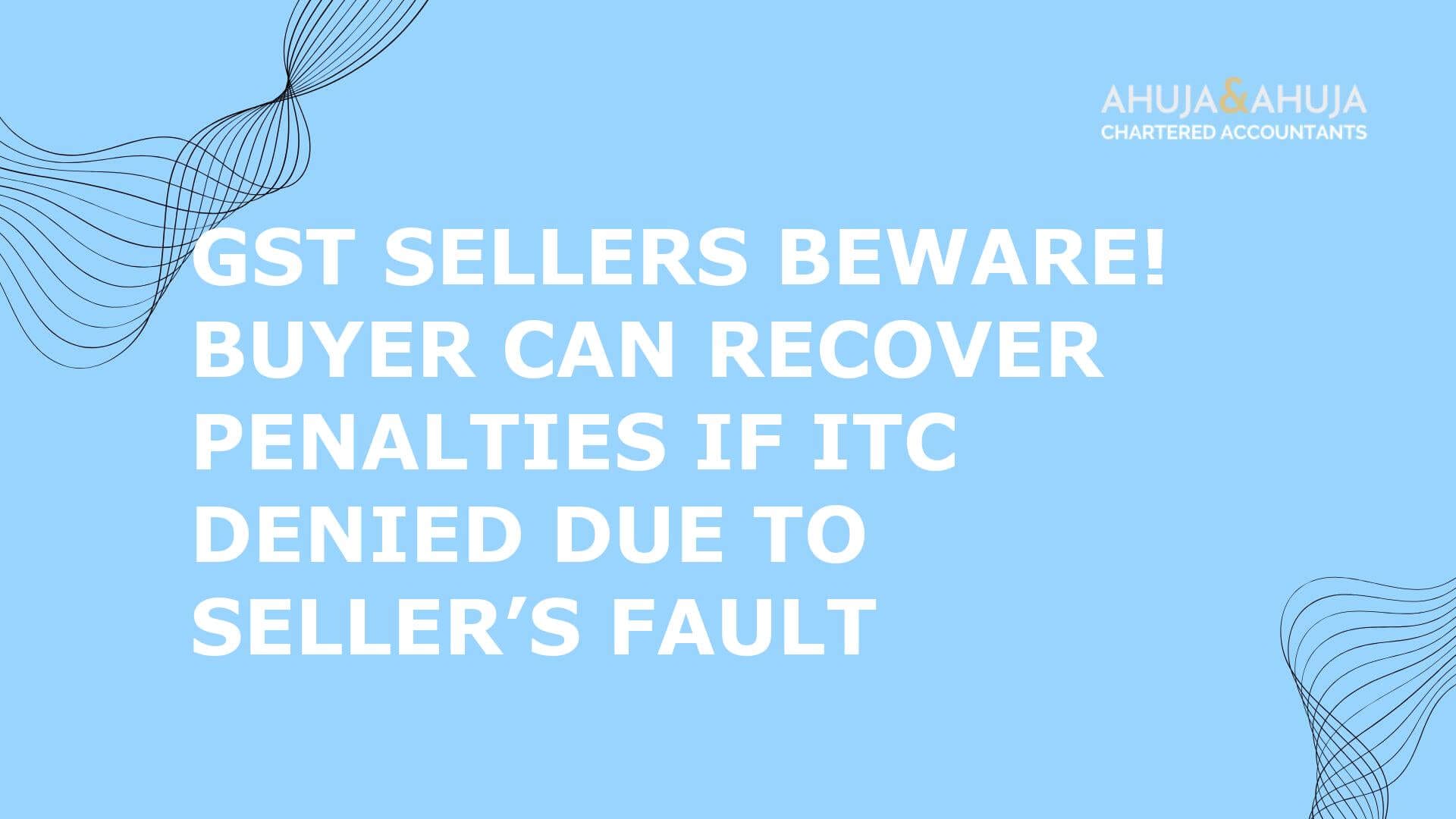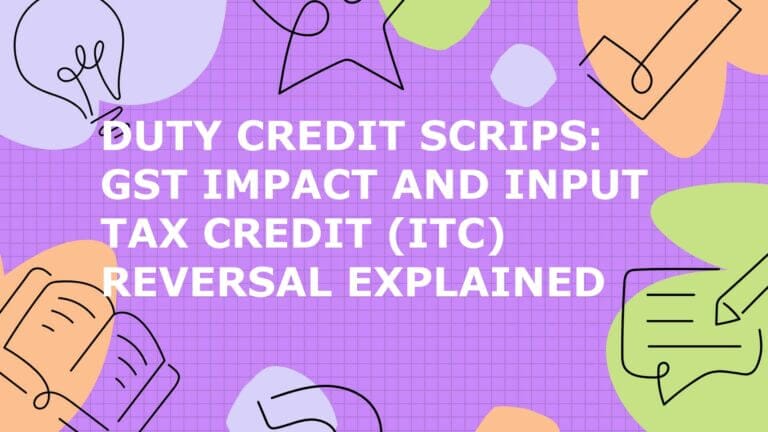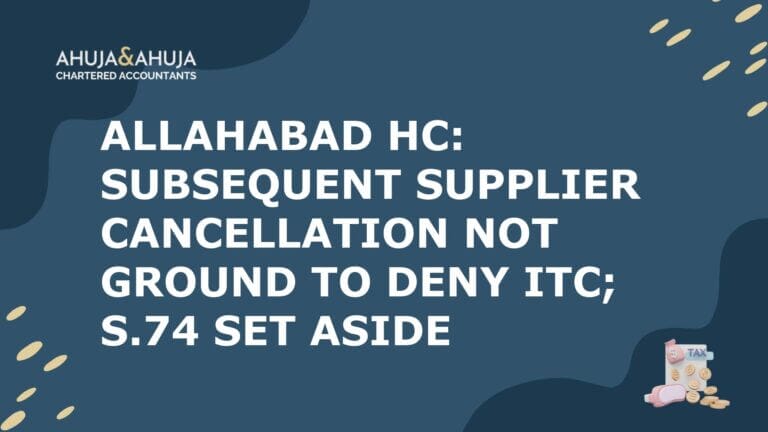GST Sellers Beware! Buyer can Recover Penalties if ITC Denied Due to Seller’s Fault
Why GST Compliance Is No Longer Just a Seller’s Problem
GST compliance in India has always been a two-way street, but the recent Allahabad High Court judgment in Surender Gupta v. NOIDA has redrawn the map. For years, buyers and sellers have navigated the GST regime with the understanding that each party must be vigilant—buyers to ensure their Input Tax Credit (ITC) is available, sellers to deposit GST correctly and file returns on time. But what happens when a seller’s mistake costs the buyer their ITC, and the tax authorities slap the buyer with a penalty? Until now, the answer was murky. This judgment brings sharp clarity—and a wake-up call for every GST-registered seller in India.
This article unpacks the judgment, explores its practical impact, and offers a roadmap for both buyers and sellers to avoid falling into similar traps. Let’s begin by understanding the case that’s set a new precedent.
The Allahabad High Court Case: Anatomy of a Costly Error
Who were the parties, and what went wrong?
The dispute centered on Surender Gupta, a property owner in Noida, and the New Okhla Industrial Development Authority (NOIDA), a government body. Gupta, acting as the head of his Hindu Undivided Family, leased out a commercial property and paid a hefty one-time lease rent to NOIDA, along with GST at 18%. NOIDA issued a tax invoice, and Gupta, believing all was in order, filed his GST return and claimed ITC.
But the devil was in the details. NOIDA, on the advice of its tax consultant, deposited the GST under the wrong head—treating the transaction as B2C (business-to-consumer) instead of B2B (business-to-business). This seemingly technical error had a domino effect: Gupta’s ITC claim was denied, and he was hit with a penalty of over ?19 lakh under Sections 73 and 74 of the CGST/UPGST Act.
How did the court untangle responsibility?
The court’s analysis was meticulous. It examined the payment trail, the GST returns, and the admissions in NOIDA’s own affidavits. NOIDA acknowledged it had received the GST from Gupta and, due to a consultant’s advice and lack of clarity in the early days of GST, deposited it incorrectly. The court noted that while Gupta could have followed up more proactively, the primary fault lay with NOIDA, which had a statutory duty to deposit GST under the correct head and file accurate returns.
Which legal provisions were at play?
Sections 39 (return filing), 73 (determination of tax not paid or short paid), and 74 (cases involving fraud or willful misstatement) of the CGST/UPGST Act formed the backbone of the legal arguments. The court also referenced the Supreme Court’s ruling in Tata Steel Ltd. (2024), emphasizing that compensation must be commensurate with the actual loss, not arbitrary or punitive.
What did the court order?
In a decisive move, the court issued a writ of mandamus directing NOIDA to compensate Gupta for the penalty amount—?19,22,778—within 15 days. NOIDA was given the right to recover this sum from the erring officer responsible for the mistake. If NOIDA failed to pay, the District Magistrate was empowered to recover the amount and pay Gupta directly. The judgment also mandated compliance reporting to ensure accountability.
Why is this a paradigm shift?
Traditionally, the principle of “buyer beware” has loomed large in GST transactions. This judgment signals a shift: sellers (including government authorities and large corporations) can no longer hide behind procedural errors or blame consultants. If their mistake leads to ITC denial and penalties for the buyer, they may be on the hook for compensation.
Risks and Repercussions for GST-Registered Sellers
This case is more than a cautionary tale—it’s a legal turning point. Sellers who make errors in GST deposit or return filing now face immediate and tangible risks:
- Legal and Financial Exposure: If a buyer is penalized due to a seller’s compliance failure, the seller may be ordered to compensate the buyer for penalties and losses.
- Precedent for Buyer Claims: The door is now open for buyers to seek recovery of penalties, interest, or even damages from sellers in similar scenarios.
- Wider Consequences: Beyond compensation, sellers risk compliance downgrades, audit scrutiny, and reputational damage. For government bodies and PSUs, the stakes are even higher—public accountability and potential recovery from individual officers. Engaging professional GST litigation services can help sellers navigate such complex situations.
Could this happen to any seller?
Absolutely. The judgment’s logic applies to any GST-registered seller—private or public, large or small. If your error (or your consultant’s) blocks a buyer’s ITC and triggers a penalty, you could be liable.
Duties, Diligence, and Defensive Strategies: Buyers’ and Sellers’ Perspectives
The Allahabad High Court’s ruling has fundamentally altered the risk calculus for both sides of a GST transaction. Let’s break down what this means in practice—and how each party can shield itself from the fallout of compliance missteps.
For Buyers: Staying Ahead of ITC Denial Risks
How can buyers spot trouble before it hits?
Red Flags:
Invoices not reflecting the correct GSTIN or transaction type (B2B vs. B2C).
Delays in receiving GST-compliant invoices or payment receipts.
Mismatches between payments made and credits reflected in GSTR-2A/2B.
Best Practices:
Maintain a robust documentation trail: Keep copies of all invoices, payment proofs, and GST challans.
Regular GST Reconciliation: Frequently match your purchase register with GSTR-2A/2B to catch discrepancies early. Learn more from our GST practical guide on input tax credit (ITC).
Prompt Communication: If ITC is not reflecting, immediately alert the seller and request rectification.
What if ITC is denied due to the seller’s error?
- Act swiftly: File representations with the seller and GST authorities, providing all supporting documents.
- Document everything: Written communication, reminders, and responses can be crucial if legal action becomes necessary.
- Know your timelines: There are statutory limits for seeking rectification and compensation—delays can weaken your claim. For more on timelines under GST, see GST time limit not mandatory: Madras High Court.
For Sellers: Bulletproofing Your GST Compliance
What steps can sellers take to avoid costly mistakes?
- Pre-deposit Checks:
- Double-check the GST head (B2B vs. B2C) before depositing tax.
- Ensure all invoices are GST-compliant and accurately reflect the buyer’s details.
- Return Filing Vigilance:
- Reconcile collections with returns before submission.
- Use automated tools or reconciliation software to flag mismatches. Consider leveraging GST return filing services for expert assistance.
- Error Correction Protocols:
- If a mistake is discovered, act immediately—file rectification applications within the prescribed deadlines.
- Keep abreast of technical glitches and GSTN advisories; document any system issues that may affect compliance.
- Consultant Oversight:
- Don’t blindly rely on external advisors. Cross-verify their advice and ensure internal checks are in place.
- If an error is consultant-driven, maintain records to establish the source of the mistake—this may be relevant for internal recovery or indemnity. Our GST consultancy services can guide you here.
Recovery Process & Practical Remedies for Buyers
How can a buyer recover penalties or losses from a seller?
- Step 1: Communication and Demand
- Formally notify the seller of the ITC denial and resulting penalty, demanding compensation.
- Provide documentary evidence: invoices, payment proofs, GST returns, and penalty orders.
- Step 2: Legal Recourse
- If the seller refuses, buyers can approach courts via writ petitions or civil suits for damages or indemnification. Our GST litigation services can support you in this process.
- The Allahabad High Court’s judgment provides a strong precedent for such claims.
- Step 3: Documentation Trail
- Success hinges on a clear, chronological record of payments, communications, and compliance efforts.
- Step 4: Timelines and Limitations
- Act within statutory limitation periods—typically three years for civil claims, but check for any GST-specific deadlines.
- Step 5: Dispute Resolution
- Consider negotiation or mediation before litigation, especially for ongoing business relationships.
Proactive Measures and Preventive Controls
What can sellers and buyers do to prevent these issues from arising?
- For Sellers:
- Implement regular GST reconciliations and set up automated alerts for mismatches.
- Draft clear contract clauses specifying GST liability, compliance responsibilities, and recourse in case of errors.
- Train staff and update internal workflows to reflect the latest GST rules and best practices. You can explore our GST audit services for compliance checks.
- For Buyers:
- Vet suppliers for GST compliance history, especially for high-value transactions.
- Establish communication protocols to confirm GST deposit and return filing soon after payment.
Legal, Policy, and Sectoral Implications
Does this judgment have a ripple effect beyond Uttar Pradesh?
Absolutely. While the case arose under the UPGST Act, the principles apply equally under the CGST regime and can influence courts across India. The judgment signals heightened judicial scrutiny of GST compliance and a growing recognition of taxpayer rights.
What about government authorities and large corporations?
The ruling is a wake-up call for PSUs and government bodies: process lapses and consultant errors are no longer shielded by institutional status. Accountability may extend to individual officers, as seen in the court’s direction allowing NOIDA to recover compensation from the erring official.
Could this lead to policy changes?
If similar cases proliferate, expect administrative refinements—perhaps clearer GSTN workflows, stricter consultant oversight, or even legislative tweaks to streamline error correction and compensation mechanisms. For insights on GST relief measures, see Introduction to GST Relief Measures in India.
Advanced Considerations and Special Scenarios
- Government and Corporate Sellers:
- The buyer’s right to recover penalties applies regardless of the seller’s status—public or private.
- Seller’s Remedies:
- If the error was due to a third-party consultant or system glitch, sellers may have recourse against those parties, but this does not absolve them of liability to the buyer.
- Risk Management Tools:
- Insurance products and contractual indemnities can help mitigate exposure.
- Invest in GST reconciliation software and process automation to minimize human error.
- Audit Trail Implications:
- Both buyers and sellers should maintain meticulous records—tax audits will scrutinize compliance, and a clear trail can be a lifesaver in disputes. Refer to our tax audit services for detailed guidance.
Key Takeaways and Compliance Checklist
The Surender Gupta v. NOIDA judgment is more than a legal milestone—it’s a practical guide for every GST-registered business. Here’s what you need to remember and implement:
For Sellers: What You Must Know and Do
- Internal controls are non-negotiable.
- Regularly reconcile GST collections with returns.
- Use automated tools to flag mismatches before filing.
- Double-check invoice details and GSTINs.
- Contracts matter.
- Include clear clauses on GST liability, error rectification, and indemnity.
- Specify timelines and procedures for addressing compliance lapses.
- Consultant oversight is your responsibility.
- Don’t rely blindly on external advice—verify, document, and cross-check through reputed GST consultancy services.
- Act fast on errors.
- Use rectification windows and communicate transparently with buyers.
For Buyers: Protecting Your ITC
- Scrutinize invoices and payment receipts for GST compliance.
- Reconcile your purchase register with GSTR-2A/2B regularly.
- Maintain a robust documentation trail.
- Keep all invoices, payment proofs, and GST correspondence.
- Document every communication with the seller regarding GST issues.
- Know your remedies.
- If ITC is denied due to the seller’s error, act promptly—demand rectification and, if needed, compensation.
- Be aware of statutory timelines for claims and legal recourse, including GST litigation services.
- Negotiate strong contract terms.
- Insist on indemnity clauses and clear GST compliance responsibilities.
Checklist for Both Parties
- [ ] Regular GST reconciliations and internal audits
- [ ] Automated alerts for mismatches or non-reflection of ITC
- [ ] Clear, GST-compliant invoicing and payment documentation
- [ ] Communication protocols for high-value or complex transactions
- [ ] Well-drafted contracts with GST-specific clauses
- [ ] Training and periodic updates for staff and consultants
- [ ] Use of technology—GST reconciliation software, workflow automation
- [ ] Insurance or indemnity arrangements for large exposures
Lessons from the Surender Gupta v. NOIDA Saga
This case is a powerful reminder: GST compliance is a shared responsibility, but the seller’s duty doesn’t end with collecting tax. It extends to correct deposit, accurate return filing, and proactive error correction through effective GST return filing services. Buyers, meanwhile, must be vigilant, maintain evidence, and assert their rights if penalized for no fault of their own.
The judgment also signals a maturing GST regime—one where courts are willing to look beyond technicalities and ensure fairness, even if it means holding government authorities and their officers personally accountable.
The Road Ahead: Joint Diligence and Robust Controls
For businesses, the message is clear:
- Review your compliance frameworks.
- Strengthen internal controls and communication.
- Negotiate contracts that allocate GST risks and remedies.
- Invest in technology and training, including GST audit services.
As judicial scrutiny intensifies and taxpayer rights evolve, those who treat GST compliance as a living, breathing process—not a box-ticking exercise—will be best positioned to avoid costly pitfalls.
Disclaimer
The materials provided herein are solely for educational and informational purposes. No attorney/professional-client relationship is created when you access or use the site or the materials. The information presented on this site does not constitute legal or professional advice and should not be relied upon for such purposes or used as a substitute for professional or legal advice.




